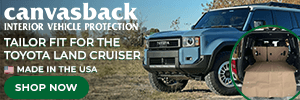All good info, thanks. I've been on some verrrry long 20+ mile cruel washboard stretches in NW Colorado where I just let it rip, without airing down, to 40 mph or more but that was in a 8000 pound conversion van. Not that I ever intend to do that again.When I said 50mph I was talking about back on pavement without airing up.
There are plenty of places I’ll go 50 on dirt but I don’t air down for that.
Navigation
Install the app
How to install the app on iOS
Follow along with the video below to see how to install our site as a web app on your home screen.
Note: This feature may not be available in some browsers.
More options
You are using an out of date browser. It may not display this or other websites correctly.
You should upgrade or use an alternative browser.
You should upgrade or use an alternative browser.
Offroading 101
- Thread starter max2me
- Start date
Make sure you can repair or swap a flat and just get on the trail.
Your lowered tire pressure depends on the trail, your tires load rating, and how much shit youre hauling in the car.
Most people spend tons of money to go on the trail in the future. Go on the trail now and spend the money in the future.
Your lowered tire pressure depends on the trail, your tires load rating, and how much shit youre hauling in the car.
Most people spend tons of money to go on the trail in the future. Go on the trail now and spend the money in the future.
Exactly.My advice is to try and join a local 4X4 club.
I went to my local 4x4 club, and with one of the members, I made a "footprint" of the front and rear tires. Using metal rulers pinched between the ground and the tire, we created a table showing the length of the footprint at various tire pressures — from normal pressure down to 4.3 psi (0.3 bar). This gave me a good idea of how the footprint size varies with pressure for my specific setup.
Surprisingly, there wasn’t much variation between 40 and 20 psi. The footprints only started to noticeably increase between 10 and 5 psi, with a very clear difference for each psi drop. That’s why it’s important to use an accurate low-pressure gauge.
Running such low pressures (below 10 psi) does come with limitations. First, I lose ground clearance. I’ve also been told to monitor tire temperature due to increased flex and speed, though that depends on the specific tire. Additionally, the power required to move the vehicle increases significantly — not to mention the common issue of de-beading.
These very low pressures are usually used on sand but can also be effective in mud. However, I often use snow chains when driving in muddy conditions.
Make sure you can repair or swap a flat and just get on the trail.
Your lowered tire pressure depends on the trail, your tires load rating, and how much shit youre hauling in the car.
Most people spend tons of money to go on the trail in the future. Go on the trail now and spend the money in the future.
Welcome to the asylum max2me.Hello,
I finally picked up my LCLC and last Sunday went on a quick trip here in Western WA. Most of it was highway, but we also took a detour for a few miles of FS roads. It was a pretty hot day, so my tire pressure was around 37 psi, and driving on forest service roads was a bit bumpy (I was going 10-20 mph depending on conditions).
Anyway, I came back home and started digging a bit more. I learned that some folks air down to 20-25 psi for forest service roads to get better comfort and reduce the risk of tire damage. This made me wonder... what else am I missing? Are there any books, videos, or online courses I could take to learn more about proper off-roading? I'd love to learn from other people's experience.
I know there's an Overland Expo coming up in OR, but I won't be able to go there to take classes this year.
PS: Do you all pick out little pebbles stuck in tires after driving on FS roads? Even after driving home for 50 miles on the highway, there were still a bunch left.
I lived in Caldwell for ~15 years, but moved away 10 years ago. I did a lot of riding (R1200GS Adventure) on less than good roads. My current GF and I are coming out west in a couple of months, and I want to show her around the ‘off road’ areas as well as show her the redwoods.I took our stock (even tires) LCLC on a long road trip this weekend. It was 100+ miles of dirt forest service roads of varying quality. LOTS of washboard. Our LC (El Si) had four humans and a dog in the back and was pulling a "SPACE" trailer full of camping gear. The truck was amazing. I aired the tires down to 25 which really helped with the washboards and it did an amazing job on one rather steep climb that I think we got super lucky on (it was a single lane with no turnarounds for about 5 miles - meeting another truck there would have been complicated to say the least - lesson learned and won't be taking the truck on that road again while towing a trailer). I'm looking forward to more appropriate tires in the future, but I'm enjoying the ride now and having fun tinkering with all the tools, seeing what works, what doesn't, and when. Can't wait to get out again!
Any suggestions?
When I lived in Idaho, the common knowledge thing that I didn’t know was, always drive in 2WD when off road. If you do, you may eventually get stuck. Then, and only then is when you select 4 wheel drive (high), and then only proceed to 4 wheel drive (low) if you cannot get unstuck in 4 high..When in doubt, get out and check the obstacle if youre not following someone experienced. There are many surprises you cant identify from behind the wheel.
Get comfortable going in and out of 4 lo, center diff lock, and rear diff lock before you need them and also be aware that these features can severely limit your turning radius and require rolling to disengage some of them.
I struggled to disengage center and rear diff (in 4Lo) previously and i felt like an idiot blocking the trail for 5 minutes because i couldnt execute 9 point turn (rear diff wouldnt unlock because i couldnt roll far enough to disengage it). If you dont know, sharp turns cant happen with rear diff and center lock engaged while on rocks
If you get stuck in 4 wheel drive, you are basically screwed, unless someone is there to pull you out.
Last edited:
So is the corollary for the full-time 4WD to stay in 4H until/unless you get stuck and only then to use 4low and the rear / center lockers? And if so, in what order?When I lived in Idaho, the common knowledge thing that I didn’t know was, always drive in 2WD when off road. If you do, you may eventually get stuck. Then, and only then is when you select 4 wheel drive (high), and then only proceed to 4 wheel drive (low) if you cannot get unstuck in 4 high..
If you get stuck in 4 wheel drive, you are basically screwed, unless someone is there to pull you out.
I would just use 2WD until I get stuck. Then use 4H. If that doesn’t work, center and rear differential will both get locked, and I will be in 4L.So is the corollary for the full-time 4WD to stay in 4H until/unless you get stuck and only then to use 4low and the rear / center lockers? And if so, in what order?
But that’s just me.
I might be wrong, just ask my X.. (I am so glad she is gone!
1) 4H, center diff unlocked (Normal street-driving mode)So is the corollary for the full-time 4WD to stay in 4H until/unless you get stuck and only then to use 4low and the rear / center lockers? And if so, in what order?
2) 4H, center diff locked (if you start spinning any tire you should lock the center diff so the torsen doesn't have to keep working to try to send more torque to the axle with traction. Better yet, lock the center diff when you first get on any lose surface and then you're driving around just like a normal part-time 4WD in 4H.)
3) 4L, center diff locked
4) 4L, center diff locked + rear diff locked. Unlock the rear diff again as soon as it's not needed.
You can throw in any of the MTS/CRAWL stuff wherever you want, but the above is how I would do it with just the mechanical options.
Then throw in the caveat that every situation is different and nothing works every time, etc.
Center differential can be unlocked in low range also
The nominal tire pressure setting is 33psi COLD (see sticker on driver’s door frame). You mentioned that your pressures were 37 psi. Perhaps you checked them after driving some distance, or you are relying on the displayed pressures? Don’t rely on the pressure displayed on the MID; mine are never listed the same as gauged pressures.Hello,
I finally picked up my LCLC and last Sunday went on a quick trip here in Western WA. Most of it was highway, but we also took a detour for a few miles of FS roads. It was a pretty hot day, so my tire pressure was around 37 psi, and driving on forest service roads was a bit bumpy (I was going 10-20 mph depending on conditions).
Anyway, I came back home and started digging a bit more. I learned that some folks air down to 20-25 psi for forest service roads to get better comfort and reduce the risk of tire damage. This made me wonder... what else am I missing? Are there any books, videos, or online courses I could take to learn more about proper off-roading? I'd love to learn from other people's experience.
I know there's an Overland Expo coming up in OR, but I won't be able to go there to take classes this year.
PS: Do you all pick out little pebbles stuck in tires after driving on FS roads? Even after driving home for 50 miles on the highway, there were still a bunch left.
Always check your starting pressures in the morning before driving.
I own a 2025 LC spec.
Good one! Just keep your fingers out of it! i have used and abused mine over the years! Still have one, is 30 years old and pulled many vehicles out of harm's way. Is perfect for winching you sideways off a tree, or from sliding off the side of trail.A simple hand cranked winch can be a life saver. I always carry one when off-roading, or even when significant snow is expected. It is not fast, but it will eventually get you unstuck you.
View attachment 40365
I love my Wyeth-Scott puller. Come alongs are a lot of work but they are awesome piece of kit.
^^^^^THIS^^^^^Always check your starting pressures in the morning before driving.
Welcome to the asylum AK-LC.
- Thread starter
- #38
Just want to circle back and say that I've finished reading this book and found it quite helpful:
It provides a good overview of mechanical bits, some driving techniques (although those require practice!) and general advice.
It provides a good overview of mechanical bits, some driving techniques (although those require practice!) and general advice.
Similar threads
- Replies
- 4
- Views
- 448
- Replies
- 38
- Views
- 3K
- Replies
- 28
- Views
- 7K


